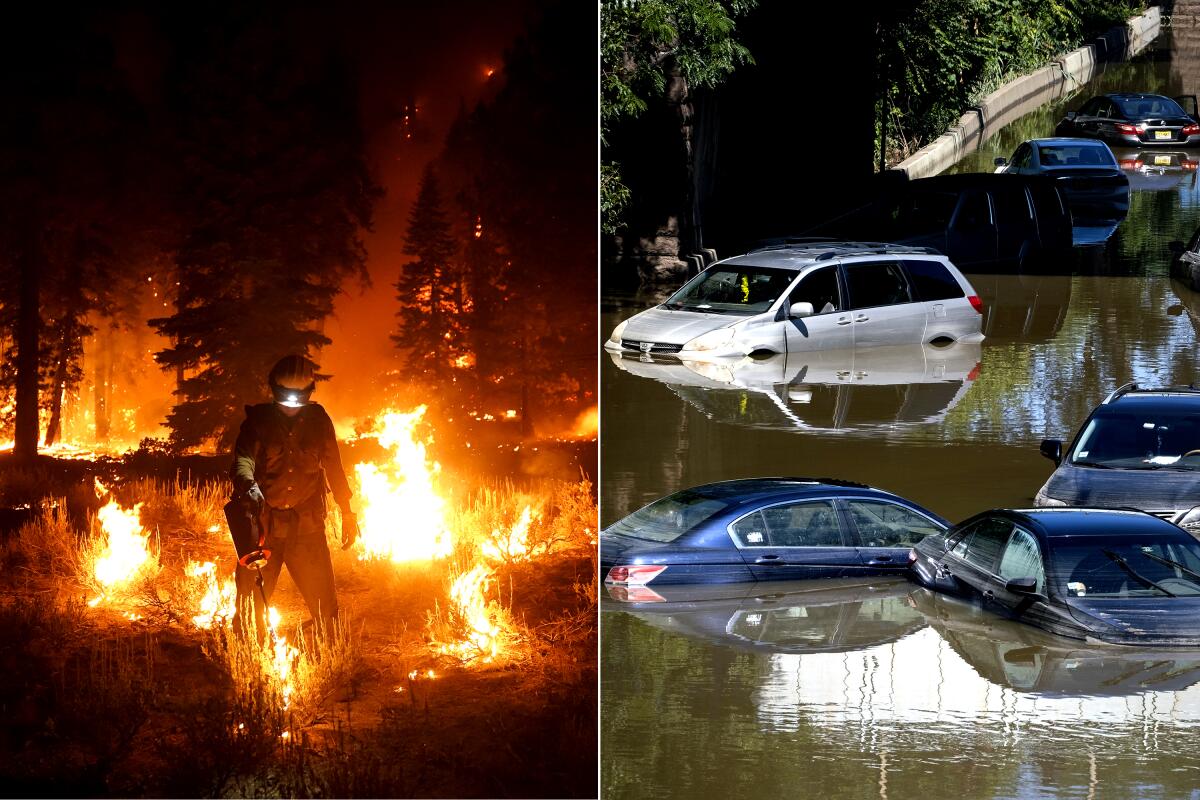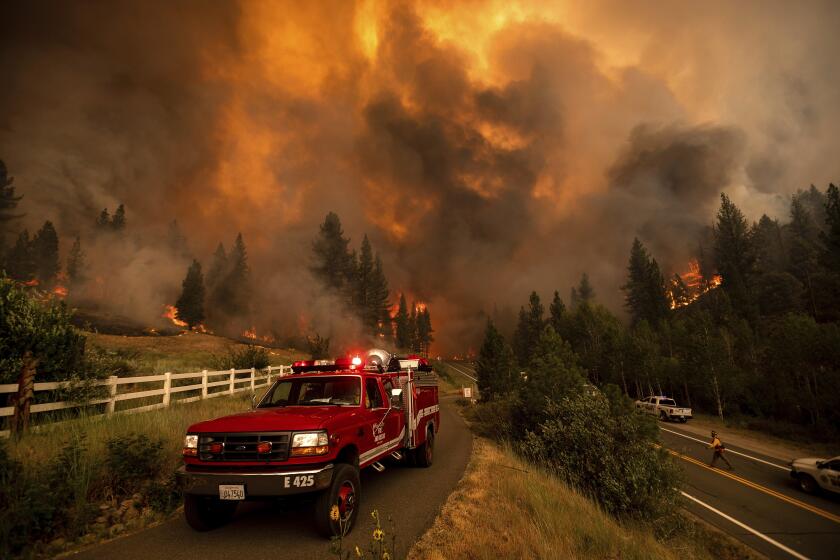Column: Our fire and flood summer predicts a catastrophic future

- Share via
Journalist Ginia Bellafante hit the nail on the head Thursday when she tweeted that the overused phrase “historic weather event” must be retired.
“It gives the ongoing climate catastrophe the hint of something novel and fun.”
The destruction of two major office towers in New York City 20 years ago was never called a “historic airplane event”; the destruction of two major cities in Japan in 1945 was not a “historic atomic event.”
Instead, these “events” were immediately understood as parts of the larger global horrors of terrorism and war. The climate crisis, too, must be addressed not as a series of one-off inconveniences — the current fires in California and the floods in New York — but as a global convulsion that is already structuring our geopolitics, our everyday lives, our futures. The climate catastrophe makes it increasingly likely that many of us in the coming decades will face injury, displacement and destitution, as we are forced to abandon damaged or destroyed homes and hometowns.
One way to comprehend the planetary convulsion is to consider the map the New York Times generated this week using data from the National Oceanic and Atmospheric Administration.
The map divides the nation by warm and cool colors. The variations don’t signal political affiliations. They don’t indicate who does and doesn’t “believe” in the climate crisis. They stand for something much more elemental: fire and water.
The data capture the 30-year change in annual average precipitation across the United States, and it’s staggering. Half of the nation has been grappling with drought while the other gets inundated.
The too-scorched West gives way to the drowned East across a surprisingly clear border that runs down the middle of the Dakotas and cuts through Texas.
Left of the line, there are a lot of amber hues, indicating that rainfall has decreased by between 1 and 5 inches since 1991.
To the right, it’s largely medium to dark aqua green. Rainfall in these areas has increased by between 2 and 5 inches in the same period. The exception is a swath of the Southern states — chiefly Georgia, North Carolina and northern Florida — that in places are about as dehydrated as Arizona.
In short, the map gives context to the West Coast’s consuming fires, the lethal storm surges in Louisiana, the flash floods in Tennessee and the Hurricane Ida aftermath that flooded houses and closed schools in New York this week.
It all adds up to a century that has broken out of the steadier weather patterns of the past, in which flood and drought were indeed “events.” It signals a breakdown of climate but, more important, a breakdown of American government and industry, which have utterly failed over the last 50 years to modify a rapacious economy that still depends on gouging stuff out of the earth and burning it.
The result can be charted: precipitation changes.
In California, two years of deep drought have set the state up for record-breaking wildfires. Already in 2021, more than 1.9 million acres have burned. Firefighters are warning that despite their all-out effort, the Caldor fire at Lake Tahoe’s edge may yet burn all the way to Nevada.
Fire suppression won’t stop the flames. We paradoxically need more fire, not less — targeted, site-specific reintroductions designed to restore ecosystem health.
Out East, the ever-warming atmosphere retains more water — and then dumps it onto communities that are not built to sustain it. Some 41 million Americans, most in the East, live near enough to a floodplain to be in urgent danger from floods.
We grow used to these numbers, which once would have terrified us.
The Great Mississippi Flood of 1927 left 500 people dead and 700,000 homeless, and cost the federal government around $1 billion, a full third of the 1927 federal budget. In response to the devastation, tens of thousands of Black Mississippians left their homes and moved North and West.
In that historical migration Americans today might see their future. Our sea-to-shining-sea nation is becoming less and less habitable. Those with means may move farther north, but even in Canada, projected precipitation maps are ominous. Almost no part of the North American continent is safe from fires or floods.
How to prepare? A famous 2007 quote by John Holdren, then Barack Obama’s senior science advisor, is apt: “We basically have three choices: mitigation, adaptation and suffering. We’re going to do some of each. The question is what the mix is going to be.”
In the name of reducing the suffering, we had better start mitigating and adapting fast. The checklist is simple but drastic. Stop taking fossil fuel from the ground and burning it, shrink livestock farming, switch to sustainable electricity. Build raised houses, relocate farms and plant heat-tolerant trees. Admit it’s happening.
The single remaining hope is that Americans will not see the amber-to-green evidence as a pretext for more infighting and blame but rather as a call to common sense, pragmatic action and moral responsibility. Mitigation and adaptation are vitally important, but only a more humane society will help us care for one another in the crisis that stretches before us.
More to Read
A cure for the common opinion
Get thought-provoking perspectives with our weekly newsletter.
You may occasionally receive promotional content from the Los Angeles Times.











